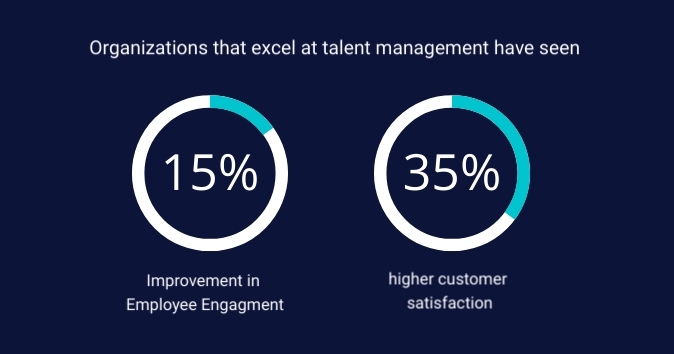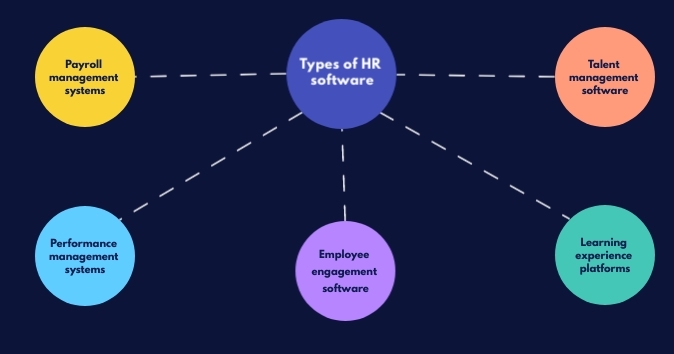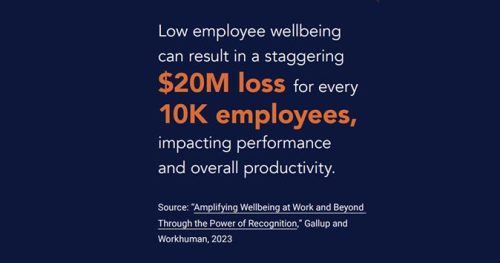Human Resource Technology: Trends and Benefits

Human resource technology solutions can offer efficiency, connectivity, and cost savings to organizations of all sizes. HR technology provides solutions for problems ranging from recruitment to employee engagement.
But educating yourself on the topic and finding the right solutions takes time and energy. We've compiled an overview of human resource technology to help you get up to speed.
Keep reading to catch up on the latest trends in human resource technology that are reshaping the future of work. Plus, discover the benefits of leveraging technology across all facets of workforce management.
What is human resource technology?
HR technology covers digital platforms and software solutions designed to streamline workflows and processes. It also includes the necessary hardware, like computers and servers, for their operation.
Technology solutions apply to various aspects of employee management, including:
- Recruitment and talent acquisition
- Onboarding
- Employee records management
- Performance management
- Learning and development
- Benefits administration
- Payroll processing
- Employee engagement
Human resource technology requires business process knowledge and technical expertise. The responsibility falls on HR and IT teams to implement and manage these systems.
What are the benefits of human resource technology?
HR technology benefits range from cost and time-saving to easier access and management of data. Let's take a closer look at the benefits below.
Improved employee scheduling and tracking
Managing schedules for employees in large organizations can be daunting. It’s even more challenging with round-the-clock operations and flexible work practices. The good news is that HR technology has made efficient scheduling easier than ever.
Software tools can generate schedules based on employee availability and workload requirements. You can track overtime hours, shift swaps, breaks, and time-offs, all while ensuring fair labor practices. Additionally, giving employees some control through self-scheduling can improve job satisfaction.
In a 2021 study, employees who used scheduling software to manage their own shifts reported improved sleep and productivityOpens in a new tab.
Easier access to crucial information
With HR technology, all employee data, from personal details to performance records, is at your fingertips. Real-time access is available to all employees in both traditional and remote work settings. Self-serving options also provide greater convenience and flexibility.
Improved talent management
Recruiting and hiring trends highlight how tech solutions enhance talent management. Applicant tracking systems can automate job postings and resume screening. They generate detailed reports and meaningful insights. Where can you find the best talent? How can you improve hiring practices?
But HR tech can go beyond recruitment. For instance, it can fast-track the onboarding process using self-guided learning to orient new hires.
Another primary aspect of talent management is nurturing homegrown talent for leadership roles. Technology tools can assist in succession planning by mapping employee skills and potential.

Cost-reduction
Automation not only streamlines operations; it can also optimize resource allocation. Ultimately, this can contribute to the company’s financial health. Fewer staff hours dedicated to HR-related paperwork mean cost savings. By digitizing human resource functions, you reduce printing, storage, and document retrieval expenses.
Another huge source of savings comes from decreased work travel for education. E-learning platforms have taken over off-site training. Employees in geographically dispersed work environments can connect using collaboration tools.
Also, automation leaves little room for human errors, which can have costly repercussions. For instance, incorrect inputs and duplicate entries, especially in payroll and benefits, can lead to hefty fines.
Proper and secure documentation
The best HR systems ensure employee records, like contracts and certifications, are secure and well-organized. Many HR software solutions offer audit trail features that track changes and access to documents. This functionality aids in transparency; you can review logs and alterations to records when needed. For maximum security, cloud storage has backups at different data servers and encrypts your files.
Types of human resources technology
There’s a full arsenal of tech solutions that HR departments use to improve the employee experience. Find out the different core HR technology systems and specialized solutions in the market today.
What are the differences between HCM, HRIS, and HRMS?
Many HR people throw around the acronyms HCM, HRIS, and HRMS like they mean the same thing. Let’s explore the subtle distinctions that set them apart.
Human Capital Management (HCM)
HCM solution is a full suite of applications used to automate a range of human resource functions, whether data-driven, transactional, or strategic. It’s an all-in-one system that allows businesses to share information among management teams.
Newer HCMs are cloud-based and as popular as ever. They boast capabilities you’re already familiar with: AI, machine learning, and mobile apps.
Human Resource Information System (HRIS)
HRIS focuses on data management, record-keeping, and reporting. In short, it takes the load off when it comes to paperwork, including payroll, tax, and benefit computation. These systems enable HR professionals to perform valuable work, like recruitment and employee development.
Human Resource Management System (HRMS)
HRMS covers broader HR processes, including the core HR functions of HRIS. While often used interchangeably, HRMS is more holistic, while HRIS is more data-centric. It has more in common with HCM, except that HCM is the more acceptable term when referring to cloud-based systems.
Types of HR software applications
Below are different types of HR software applications for specific HR functions:

Payroll management systems
Payroll management systems automate the computation of salaries, including taxes, deductions, and benefits. These tools help reduce errors in payroll processing and ensure compliance with tax laws.
Talent management software
Talent management suites help organizations attract, retain, and nurture employees. It includes modules for the following HR functions:
- recruiting
- onboarding
- learning and development
- succession planning
Performance management systems
Performance management modules can track employee progress using feedback and reviews. Another feature is interactive employee feedback in a process called continuous performance management.
For instance, Workhuman® Conversations® facilitates positive manager-employee interactions using online check-ins. You can also use this tool to share goals and updates within teams.
Employee engagement software
Employee engagement software gathers employee feedback and generates reports using any combination of criteria. Digital HR platforms can track employee sentiment and diagnose corporate issues.
Want to build employee engagement? Workhuman can help you create a true culture of recognition within the walls of your organization.
Learning experience platforms
Traditional in-person training costs time, money, and resources. Digital learning is a modern solution that helps employees gain new skills and knowledge at their convenience. Additionally, these learning platforms can provide detailed reporting of completion, assessments, and areas where extra support is necessary.
It also makes training accessible to all employees at the same time, no matter where they are working. This means your budget for training expenses (e.g., travel costs and training materials) will decrease.
See also: Benefits Certifications for HR
How to leverage technology in HR processes
Consider these ways to maximize the use of technology in your department:
Attract a skilled and inclusive workforce
Tech solutions can help ensure job listings are inclusive and bias-free. For instance, a resume parser extracts data into structured tidbits and saves them in segregated fields. You can then match the job to specific skills, qualifications, and past experiences, regardless of age, gender, or race.
Select a diverse set of employees
Anti-discrimination laws protect traits like age, race, and sexual orientation in the workplace. Talent management technology recognizes competencies rather than protected characteristics. Assessment tools can also help identify candidates who best fit the role, no matter their background.
Enhance employee knowledge, skills, and capabilities
Using performance management software, you can create learning paths based on skills and career goals. This personalized approach ensures employees receive training that directly benefits their growth.
Manage and improve employee performance
Technology enables continuous performance management through goal-tracking and regular feedback. In return, this fosters a culture of growth and accountability.
Foster motivation and boost retention
Engaged employees are more likely to perform well and stay with the company. You can assess employee satisfaction and identify pain points through HR platforms. From these results, you can take proactive steps to boost motivation and improve the employee experience.
HR tech trends in 2025
From best practices to AI integration, below are this year’s latest HR tech trends:
Ensuring employee well-being and safety
This trend includes tools that monitor employee well-being, especially with ongoing workplace stressors. HR tech solutions can assist in stress management, wellness support, and safety protocols.

Creating a more personalized employee experience
The employee experience has been a top strategic objective for the past few years, and it’s no different in 2025. You can use communication tools to send targeted emails or messages based on interests or milestones. You can also personalize training modules with learning management platforms. Or, you can use adaptive technology to adjust content based on individual progress.
Strengthening skills development initiatives
Upskilling took a backseat as businesses dealt with post-pandemic concerns like safety protocols and mental health. Today, employee skills are having a moment. HR tech providers have newer tools that can create personalized guidance for skill development. Moreover, data analytics can identify skills gaps and match skills to organizational needs.
Enabling effective leadership training and empowerment
Succession planning is an important HR function that involves nurturing future company leaders. Comprehensive HR suites can generate meaningful insights into an employee’s potential. To aid in learning and development, you can use talent management and learning tools.
Promoting transparency and security in AI implementation
This trend emphasizes the need for clear explanations of how AI systems are used in HR workflows. This is to ensure fairness and avoid biases in recruitment, talent management, and succession planning.
To build trust and confidence in AI-driven solutions, another priority is data privacy. HR leaders commit to protecting sensitive employee information from unauthorized access and misuse.
Up-and-coming human resources technology
Here are some HR technology trends that can dominate the modern workplace in 2025 and beyond.
HR strategic initiatives
HR strategy ensures that human resource processes align with the company's brand and culture. For one, improving the employee experience is a strategic priority that can reap rewards for the company.
At its core, the employee experience is a positive force that drives people to invest more of themselves in the workplace. Data-driven insights and tools can steer this initiative in the right direction.
You might like: 7 successful HR strategy examples that work
Cloud-based HR systems
Cloud-based HR suites are off-site, centralized, and fully automated. These online platforms make HR operations more accessible, efficient, and flexible. They allow HR teams and employees to communicate with the system on the go. You only need a mobile device and an internet connection to access HR services.
AI-powered data analytics
AI will help HR managers screen candidates and streamline succession planning as it can process vast volumes of data through machine learning in HR analytics. For example, it can sift through thousands of resumes and identify the best candidates based on predefined criteria.
Blockchain integration
Blockchain extends beyond cryptocurrencies. It’s starting to make inroads into workforce analytics and people management. But what is blockchain exactly?
Unlike centralized systems, blockchain operates on a decentralized network of computers called nodes. It’s a distributed database that stores data in a secure and tamper-proof manner.
Blockchain can enhance efficiency and transparency in various HR processes by verifying the credentials and qualifications of job candidates, automating background checks, and simplifying onboarding.
FAQs
Why is HR technology important?
HR technology automates many repetitive and time-consuming tasks, like payroll processing. It can reduce human errors in HR processes, which can have significant legal and financial implications. But that’s not all. Current HR trends can improve productivity, job satisfaction, and the quality of new hires.
What is artificial intelligence in HR?
AI is more than HR chatbots for employee support. AI-driven learning experience platforms can provide personalized learning paths for employees. With machine learning, AI can analyze inclusion metrics and turnover rates for workforce planning.
Conclusion
Human resource technology is changing the way HR leaders manage the workforce. By automating administrative tasks, HR professionals can focus on employee well-being and development.
Cloud, blockchain, and AI are already gaining traction. Looking ahead, you can expect more digital platforms built on them. Stay informed of emerging HR trends to create an inclusive, efficient, and productive work environment.
About the author
Ryan Stoltz
Ryan is a search marketing manager and content strategist at Workhuman where he writes on the next evolution of the workplace. Outside of the workplace, he's a diehard 49ers fan, comedy junkie, and has trouble avoiding sweets on a nightly basis.